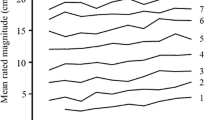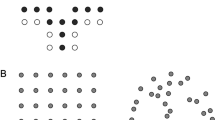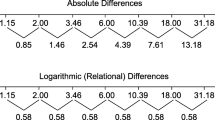Summary
This paper describes an extension of Preferred State Theory (Baird, 1975) to deal with matching functions produced by such techniques as magnitude and category estimation. It is assumed by this theory that all stimulus attributes are transformed into perceptual states according to the operation of mathematical base systems. Intensities are matched across attributes in terms of the number of preferred states generated by each. The theory provides quantitative explanations for a variety of psychophysical effects, including the prothetic-metathetic distinction, the selective applicability of Fechner's and Stevens' laws, and the success of transitivity tests among exponents.
Similar content being viewed by others
References
Attneave, F.: Perception and related areas. In: Psychology: A study of a science, Vol. 4 (Koch, S., Ed.). New York: McGraw Hill 1962
Baird, J. C.: A cognitive theory of psychophysics. I. Information transmission, partitioning, and Weber's law. Scand. J. Psychol. 11, 35–46 (1970a)
Baird, J. C.: A cognitive theory of psychophysics. II. Fechner's law and Stevens' law. Scand. J. Psychol. 11, 89–102 (1970b)
Baird, J. C.: Psychophysical analysis of visual space. London: Pergamon 1970c
Baird, J. C.: Psychophysical study of numbers: IV. Generalized preferred state theory. Psychol. Res. (1975)
Baird, J. C., Lewis, C., Romer, D.: Relative frequencies of numerical responses in ratio estimation. Perception and Psychophysics 8, 358–362 (1970)
Baird, J. C., Noma E.: Psychophysical study of numbers: I. Generation of numerical responses. Psychol. Res. 37, 281–287 (1975)
Baird, J. C., Stein, T.: When power functions fail: A theoretical explanation. Perceptual and Motor Skills 30, 415–425 (1970)
Banks, W. P.: A new psychophysical ratio scaling technique: Random Production. Bull. Psychonomic Soc. 1, 273–275 (1973)
Eisler, H.: A general differential equation in psychophysics. Scand. J. Psychol. 4, 265–272 (1963)
Eisler, H., Montgomery, H.: On theoretical and realizable ideal conditions in psychophysics: Magnitude and category scales and their relation. Göteborg Pschological Reports. The University of Göteborg 2, No. 16 (1972)
Ekman, G.: Subjective power functions and the method of fractionation. Reports from the Psychological Laboratories. The University of Stockholm, No. 34 (1956)
Ekman, G.: Weber's law and related functions. J. Psychol. 47, 343–352 (1959)
Ekman, G.: Is the power law a special case of Fechner's law? Perceptual and Motor Skills 19, 73 (1974)
Ekman, G., Sjöberg, L.: Scaling. Annual Review of Psychology 16, 451–474 (1965)
Engen, T., Levy, N.: The influence of standards on psychophysical judgments. Perceptual and Motor Skills 5, 193–197 (1955)
Engen, T., Ross, B. M.: Effect of reference number of magnitude estimation. Perception and Psychophysics 1, 74–76 (1966)
Fechner, G.: Elemente der Psychophysik, Vol. II. Leipzig: Breitkopf and Bartel 1907
Freides, D., Phillips, P.: Power law fits to magnitude estimates of groups and individuals. Psychonomic Sci. 5, 367–368 (1966)
Gibson, R.H., Tomko, D. L.: The relation between category and magnitude estimates of tactile intensity. Perception and Psychophysics. 12, 135–138 (1972)
Graf, V., Baird, J. C., Glesman, G.: An empirical test of two psychophysical models. Acta psychol. 38, 59–72 (1974)
Helm, C. E., Messick, S., Tucker, L. R.: Psychological models for relating discrimination and magnitude estimation scales. Psychol. Rev. 68, 167–177 (1961)
Helson, H.: Adaptation-level theory. New York: Harper and Row 1964
Künnapas, T.: Scales for subjective distance. Scand. J. Psychol. 1, 187–192 (1960)
Luce, R. D., Mo, S. S.: Magnitude estimation of heaviness and loudness by individual subjects: A test of a probabilistic response theory. British Journal of Mathematical and Statistical Psychology 18, 159–174 (1965)
Marks, L. E.: Stimulus range, number of categories, and form of the category scale. Amer, J. Psychol. 81, 467–479 (1968)
Marks, L. E., Stevens, J. C.: The form of the psychophysical function near threshold. Perception and Psychophysics 4, 315–318 (1968)
Mashhour, M., Hosman, J.: On the new psychophysical law. A validation study. Perception and Psychophysics 3, 367–375 (1968)
McGill, W.: The slope of the loudness function. A puzzle, p. 67–81. In: Psychological scaling: Theory and applications (Gulliksen, H., Messick, S., Eds.) New York: Wiley 1960
McKay, D. M.: Psychophysics of perceived intensity: A theoretical basis for Fechner's and Stevens' laws. Science 139, 1212–1216 (1963)
Noma, E., Baird, J. C.: Psychophysical study of numbers. II. Theoretical models of number generation. Psychol. Res. 38, 81–96 (1975)
Poulton, E. C.: The new psychophysics: Six models for magnitude estimation. Psychol. Bull. 69, 1–19 (1968)
Poulton, E. C.: Choice of first variables for single and repeated multiple estimates of loudness. J. exp. Psychol. 80, 249–253 (1969)
Pradhan, P. L., Hoffman, P. J.: Effect of spacing and range of stimuli on magnitude estimation judgments. J. exp. Psychol. 66, 533–541 (1963)
Stevens, S. S.: On the brightness of lights and the loudness of sounds. Science 118, 576 (1953) (Abstract)
Stevens, S. S.: To honor Fechner and repeal his law. Science 133, 80–86 (1961)
Stevens, S. S.: On the operation known as judgment. American Scientist 54, 385–401 (1966a)
Stevens, S. S.: A metric for the social consensus. Science 151, 530–541 (1966b)
Stevens, S. S.: Neural events and the psychophysical law. Science 170, 1043–1050 (1970)
Stevens, S. S.: Issues in Psychophysical measurement. Psychol. Rev. 78, 426–450 (1971)
Stevens, S. S., Galanter, E. H.: Ratio scales and category scales for a dozen perceptual continua. J. exp. Psychol. 54, 377–411 (1957)
Teghtsoonian, R.: On the exponents in Stevens' law and the constant in Ekman's law. Psychol. Rev. 8, 71–80 (1971)
Treisman, M.: Sensory scaling and the psychphysical law. Quart. J. exp. Psychol. 16, 11–22 (1964)
Wandmacher, J.: Die Trennung von sensorischen und Urteilsprozessen bei der Größen- und Verhältnisschätzung. Doctoral dissertation, University of Hamburg (1970)
Ward, L. M.: Category judgments of loudnesses in the absence of an experimenter-induced identification function: Sequential effects and power function fit. J. exp. Psychol. 94, 179–184 (1972)
Ward, L. M.: Repeated magnitude estimations with a variable standard: Sequential effects and other properties. Perception and Psychophysics 13, 193–200 (1973)
Ward, L. M., Lockhead, G. R.: Response system processes in absolute judgment. Perception and Psychophysics 9, 73–78 (1971)
Weissmann, W. M., Holligsworth, S. R., Baird, J. C.: Psychophysical study of numbers. III. Methodological applications. Psychol. Res. 38, 97–115 (1975)
Wong, R.: Effect of the modulus on estimates of magnitude of linear extent. Amer. J. Psychol. 76, 511–521 (1963)
Author information
Authors and Affiliations
Additional information
This article is the last in a series. The ideas discussed here were first presented at the 1973 meetings of the Psychonomic Society. I am grateful to Charles Lewis, Elliot Noma, and Stephen Weissmann for their encouragement and advice on many aspects of the work.
Rights and permissions
About this article
Cite this article
Baird, J.C. Psychophysical study of Numbers. Psychol. Res 38, 189–207 (1975). https://doi.org/10.1007/BF00308524
Received:
Issue Date:
DOI: https://doi.org/10.1007/BF00308524




